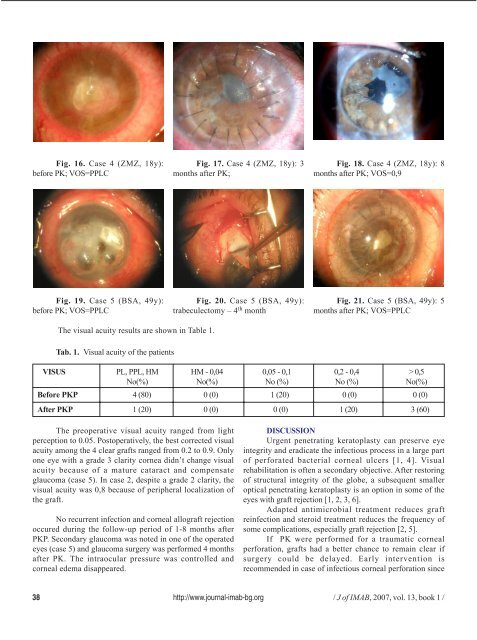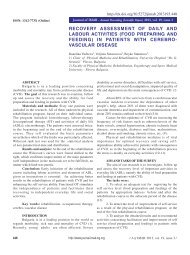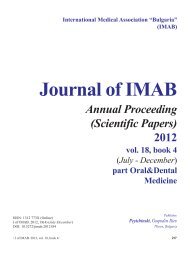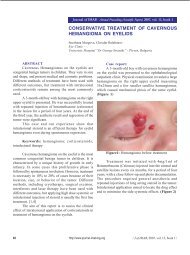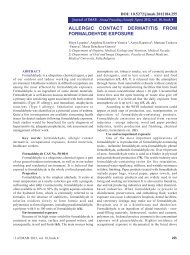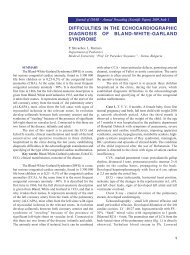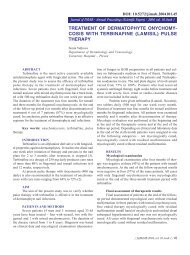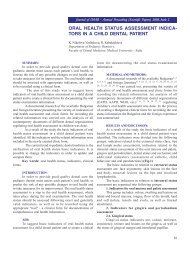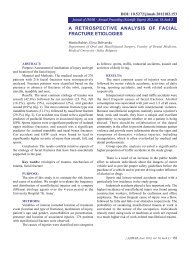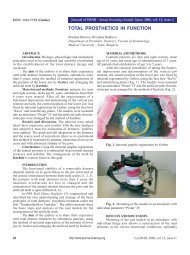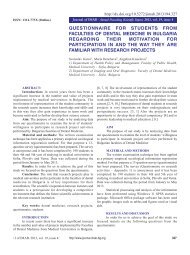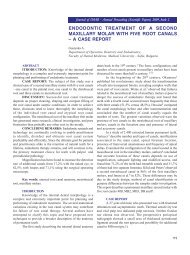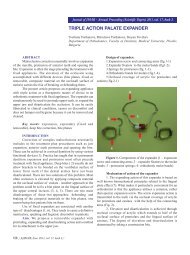treatment of perforated infectious corneal ulcers - Journal of IMAB
treatment of perforated infectious corneal ulcers - Journal of IMAB
treatment of perforated infectious corneal ulcers - Journal of IMAB
Create successful ePaper yourself
Turn your PDF publications into a flip-book with our unique Google optimized e-Paper software.
Fig. 16. Case 4 (ZMZ, 18y):<br />
before PK; VOS=PPLC<br />
Fig. 17. Case 4 (ZMZ, 18y): 3<br />
months after PK;<br />
Fig. 18. Case 4 (ZMZ, 18y): 8<br />
months after PK; VOS=0,9<br />
Fig. 19. Case 5 (BSA, 49y):<br />
before PK; VOS=PPLC<br />
Fig. 20. Case 5 (BSA, 49y):<br />
trabeculectomy – 4 th month<br />
Fig. 21. Case 5 (BSA, 49y): 5<br />
months after PK; VOS=PPLC<br />
The visual acuity results are shown in Table 1.<br />
Tab. 1. Visual acuity <strong>of</strong> the patients<br />
VISUS PL, PPL, HM HM - 0,04 0,05 - 0,1 0,2 - 0,4 > 0,5<br />
No(%) No(%) No (%) No (%) No(%)<br />
Before PKP 4 (80) 0 (0) 1 (20) 0 (0) 0 (0)<br />
After PKP 1 (20) 0 (0) 0 (0) 1 (20) 3 (60)<br />
The preoperative visual acuity ranged from light<br />
perception to 0.05. Postoperatively, the best corrected visual<br />
acuity among the 4 clear grafts ranged from 0.2 to 0.9. Only<br />
one eye with a grade 3 clarity cornea didn’t change visual<br />
acuity because <strong>of</strong> a mature cataract and compensate<br />
glaucoma (case 5). In case 2, despite a grade 2 clarity, the<br />
visual acuity was 0,8 because <strong>of</strong> peripheral localization <strong>of</strong><br />
the graft.<br />
No recurrent infection and <strong>corneal</strong> allograft rejection<br />
occured during the follow-up period <strong>of</strong> 1-8 months after<br />
PKP. Secondary glaucoma was noted in one <strong>of</strong> the operated<br />
eyes (case 5) and glaucoma surgery was performed 4 months<br />
after PK. The intraocular pressure was controlled and<br />
<strong>corneal</strong> edema disappeared.<br />
DISCUSSION<br />
Urgent penetrating keratoplasty can preserve eye<br />
integrity and eradicate the <strong>infectious</strong> process in a large part<br />
<strong>of</strong> <strong>perforated</strong> bacterial <strong>corneal</strong> <strong>ulcers</strong> [1, 4]. Visual<br />
rehabilitation is <strong>of</strong>ten a secondary objective. After restoring<br />
<strong>of</strong> structural integrity <strong>of</strong> the globe, a subsequent smaller<br />
optical penetrating keratoplasty is an option in some <strong>of</strong> the<br />
eyes with graft rejection [1, 2, 3, 6].<br />
Adapted antimicrobial <strong>treatment</strong> reduces graft<br />
reinfection and steroid <strong>treatment</strong> reduces the frequency <strong>of</strong><br />
some complications, especially graft rejection [2, 5].<br />
If PK were performed for a traumatic <strong>corneal</strong><br />
perforation, grafts had a better chance to remain clear if<br />
surgery could be delayed. Early intervention is<br />
recommended in case <strong>of</strong> <strong>infectious</strong> <strong>corneal</strong> perforation since<br />
38 http://www.journal-imab-bg.org / J <strong>of</strong> <strong>IMAB</strong>, 2007, vol. 13, book 1 /


